I need to set the stage on what this dive watch means to me and how it has shaped my collecting journey. The Seiko Marinemaster 300’s legendary shadow has always loomed over me. I am a rampant Seikoholic – Seiko is easily my favorite brand and has been since nearly the origin of my watch collecting obsession.
When I first got into horology, the Seiko SKX007 was my grail watch. I loved its specs, uncompromised tool watch style, and I loved what Seiko watches offered and stood for. I got an SKX and loved it (and I still do), and grew to love the iconic Japanese brand even more. As I learned more about Seiko and other dive watch models they offered like the Tuna, Turtle, and the Samurai, I was introduced eventually to the Marinemaster.
It appeared to be, and quite frankly is, the ultimate expression of the Seiko diver ethos that I loved so much. So I have always put the Marinemaster on a pedestal, at the forefront of what I was searching for but always just out of reach for a myriad of reasons. The Marinemaster was too expensive, too big, too thick, too hard to service, and too luxurious to occupy a tool watch slot in my collection. It was just a little too much in too many ways on the wrong side of the scale, so I held off purchasing one for nearly 10 years.
Seiko Marinemaster 300 Specs
| Case Dimensions | 44mm x 50.5mm x 15.4mm |
| Lug Width | 20mm |
| Material | Stainless Steel Case With Ceramic Insert Bezel |
| Crystal | Sapphire Crystal |
| Water Resistance | 300m |
| Movement | Seiko 8L35 (Automatic Movement) |
| Power Reserve | 50 Hours |
| Accuracy | +15 / -10 seconds per day |
| Manual Winding | Yes |
| Hacking | Yes |
| Price: | $3,100 |
I went through perhaps 7 or 8 SKXs and some Seiko 5 series divers. I bought a Seiko Sumo SBDC033 and kept it for a couple years, and then I bought a SPB187 ‘Marinemaster 200.’ They all were great watches, but they all fell short of the specific itch I needed scratching. The ‘MM200’ was the closest I got, as it has about 85% of the Marinemaster look and feel at a cheaper price point and in a much more wearable case size. Then not too long ago, almost on a whim and with some encouragement from some bad influences, I sold almost all my Seikos and purchased a SLA023j1 Blue Seiko Marinemaster, and I haven’t looked back.
Weight and Wearing Experience
The Seiko Marinemaster 300 really is its own beast, and beast is probably the most apt description. This timepiece is quite large in nearly every proportion, and Seiko’s historical ability to have large cases wear comfortably isn’t able to curb that fact (note for those who aren’t familiar – Seiko diver case dimensions historically employ some sort of witchcraft where case dimensions are large on paper, but very comfortable on the wrist).
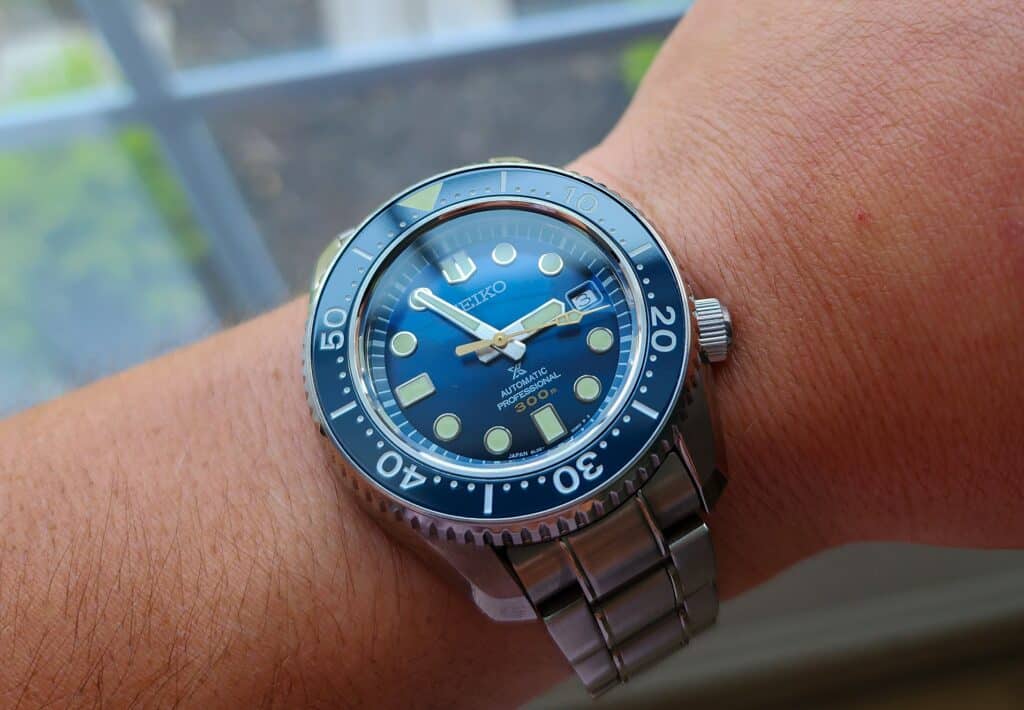
I have had some big watches before, but what struck me most here is the weight. With the bracelet this watch weighs around 200 grams. To put that in perspective, that is 5gs more than a solid white gold Daytona on a bracelet and about 60gs more than an SKX. The MM300 takes some getting used to, and its weight in my opinion is what stops it from being a wear and forget type of watch.
Hefty Stainless Steel Bracelet In A Competitive Price Point
I almost instantly binned my bracelet on this watch. It’s not a horrendous bracelet in its own right. It is finished decently well and I actually really like the ratcheting, quick adjust clasp. I like the clasp so much that when I had the MM200 SPB187 I purchased this MM300 style clasp to complete that bracelet. It is easy to adjust while fastened to your wrist and has loads of positions to choose from.
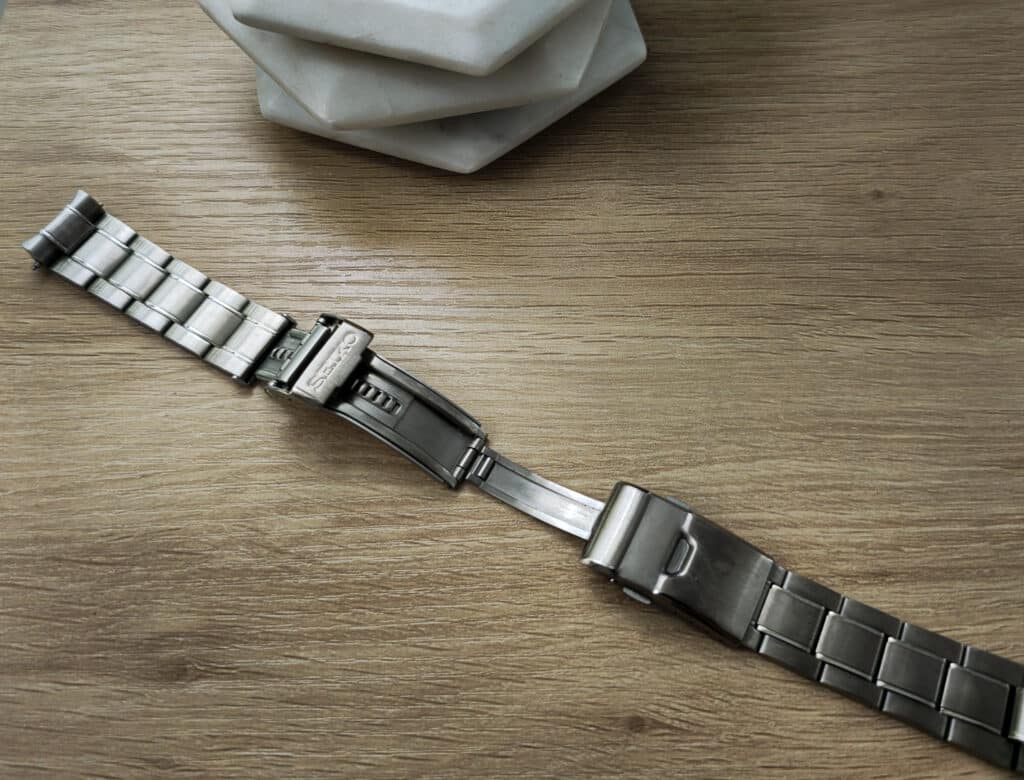
Unlike the glide-lock on a Sub, this bracelet has enough expanding adjustment that you can size it for your naked wrist and then use the same settings plus the extension to get over a wetsuit. It ratchets out a bit every time you slide the watch on and off which annoys some, but it is very easy to pinch it back to the normal place as the watch is affixed to your wrist so I don’t mind in the slightest.
The primary problem with this bracelet is its peerage. At $3,100 retail, this sits right alongside the bracelets on the Tudor Ranger, Longines Spirit, and many others that are simply in a different league of quality. If you have a Seiko SPB143 or Seiko SPB187, the bracelet on your watch is actually a bit better than the bracelet on this watch that costs three times the money.
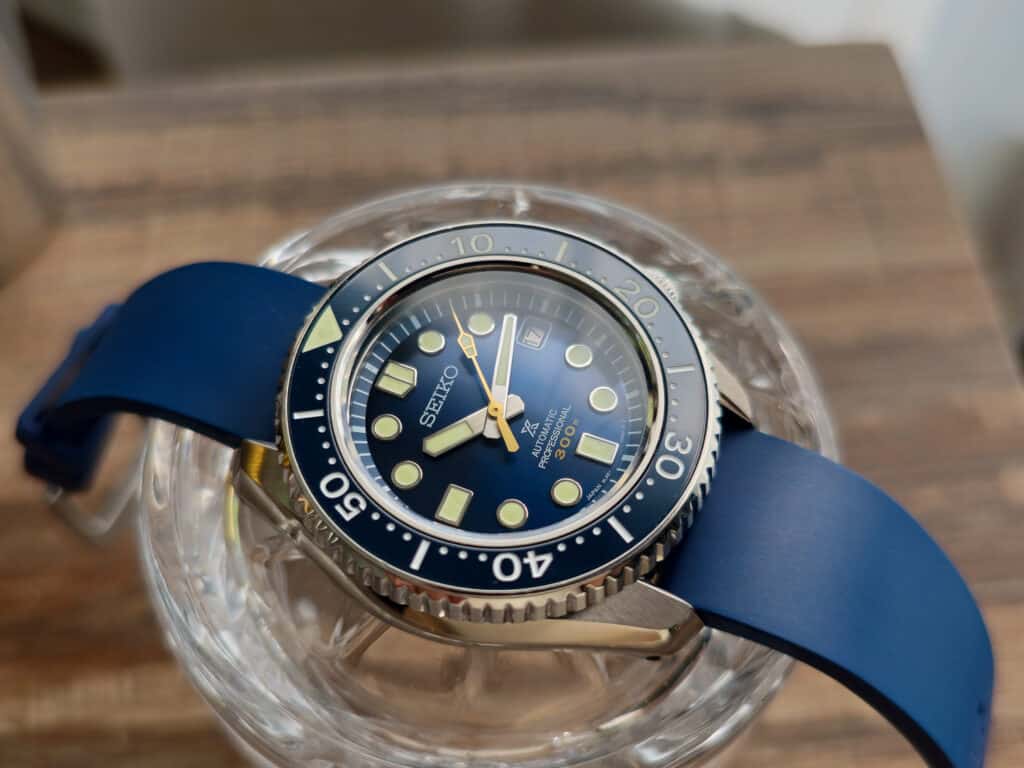
This bracelet also suffers from the same affliction that the pre-coaxial Speedmaster had, it thinks heft is synonymous with quality. The links are long, about 50% longer than the counterparts found in an oyster bracelet, and they do not articulate very well. The endlinks are male endlinks, which adds another couple millimeters to an already insane 50.5mm lug to lug.
Between the general lack of quality, poor design, and outrageous weight, I honestly think this watch is borderline unwearable on its bracelet. This is a watch that costs over three thousand dollars, there is no excuse and this could rightly be a deal breaker for some.
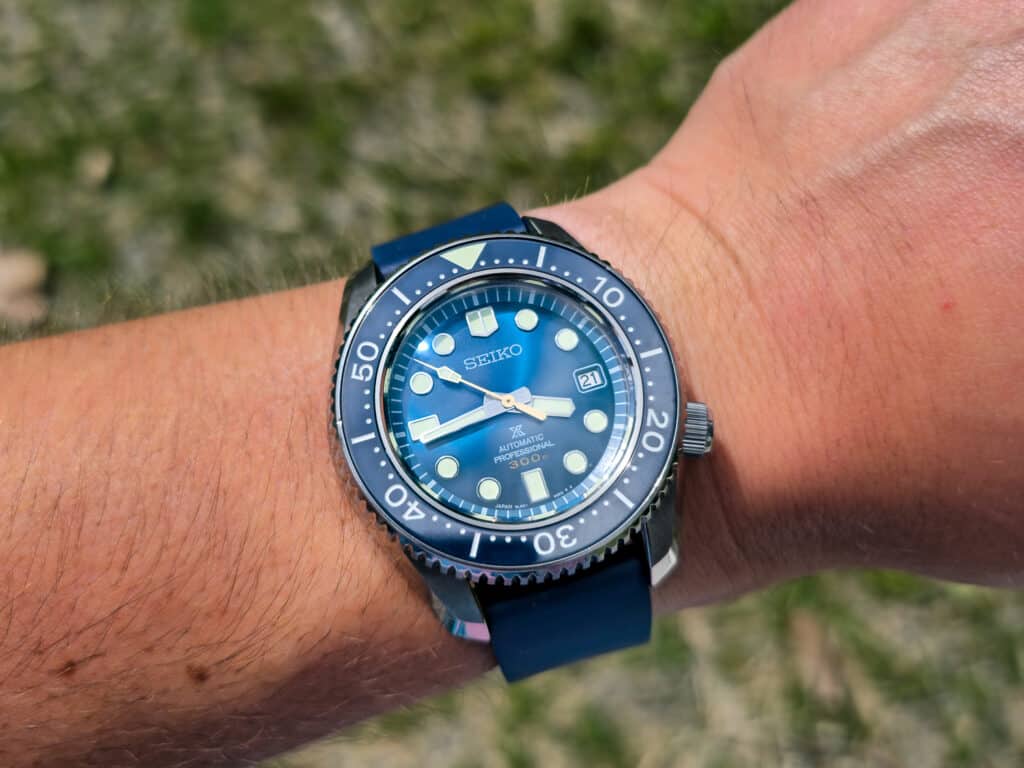
I wear this watch exclusively on an aftermarket matching blue FKM rubber strap or a single pass NATO strap, and they completely transform this watch into one of the more wearable pieces in my collection. This is one of those watches that relies on its charm to elicit forgiveness for its OEM strap options, and for better or worse Seiko is the best in the business at that. I have allowed myself to look past this deficiency and have become enamored by the beautiful watch head.
Monocoque Case With Iconic Zaratsu Polishing
The case on the MM300 is quite large, and I know it has been said before but this watch truly does not wear all that much bigger than a modern ceramic Submariner. It is a monocoque case, which means that there is no case back and the case is one solid piece of stainless steel.
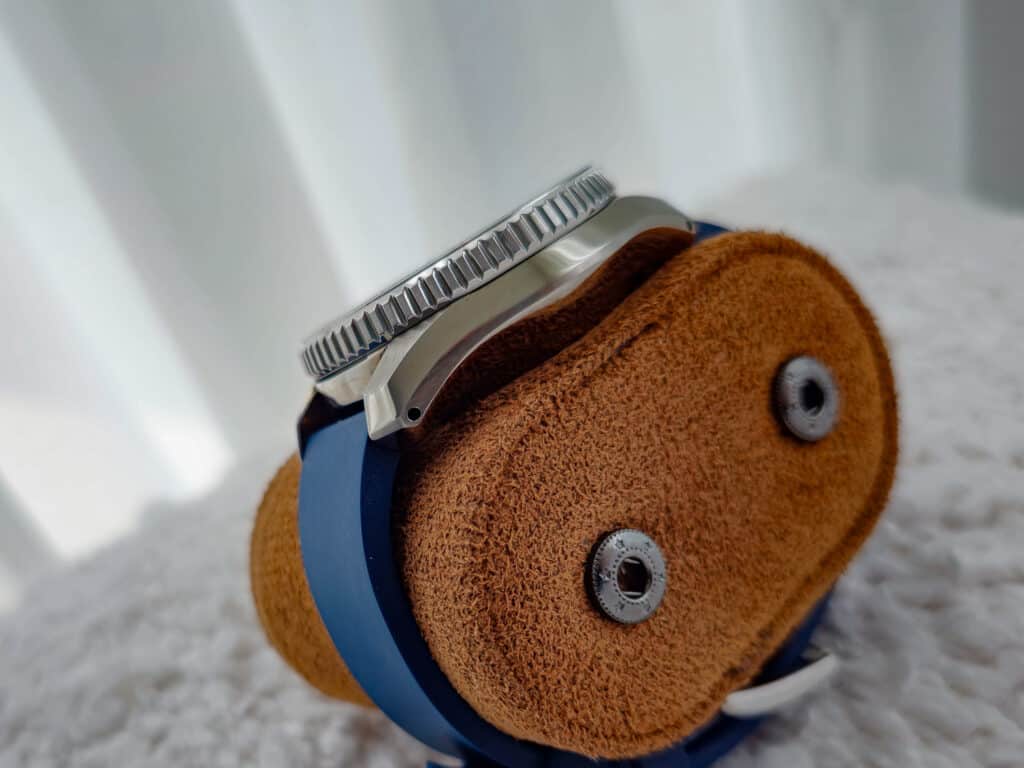
Instead the movement, dial, and hands are loaded into the watch through the front of the watch, necessitating a lengthy trip back to Japan if a service is ever required. This type of case construction supports the 300m of water resistance. The back of the case is smooth to the touch and pretty sterile, save a small embossed Seiko Wave and some minimal printing. Drilled lugs make it easy to remove that horrid bracelet.
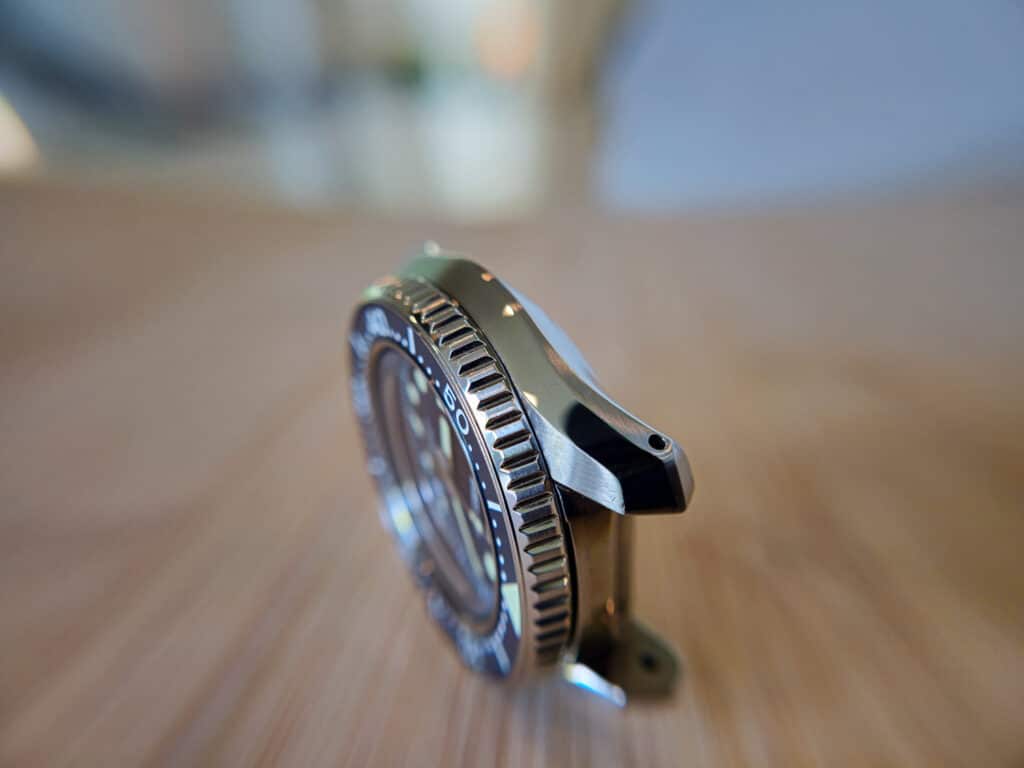
The central, flat part of the back of the case is just shy of 30mm wide and the bezel at its widest is about 40mm, which means that the sides of the case are at two sharply opposing oblique angles as they meet at the 44mm case edge. If you hold the watch with the crown pointing up it looks like the case slopes up to the peak of a lopsided volcanic mountain and then subtly back down to the bezel. This makes the widest portion of the watch when you look down at it on your wrist not the dial or bezel, but the zaratsu polished sides that flank a thin, flat bevel that runs the length of the case back.
I can’t believe I am halfway through the review before I mentioned the zaratsu polishing, but it is genuinely some of the best polishing I have seen on a watch. This is polishing that is done by hand by wizards with years of experience in Grand Seiko’s best workshops.
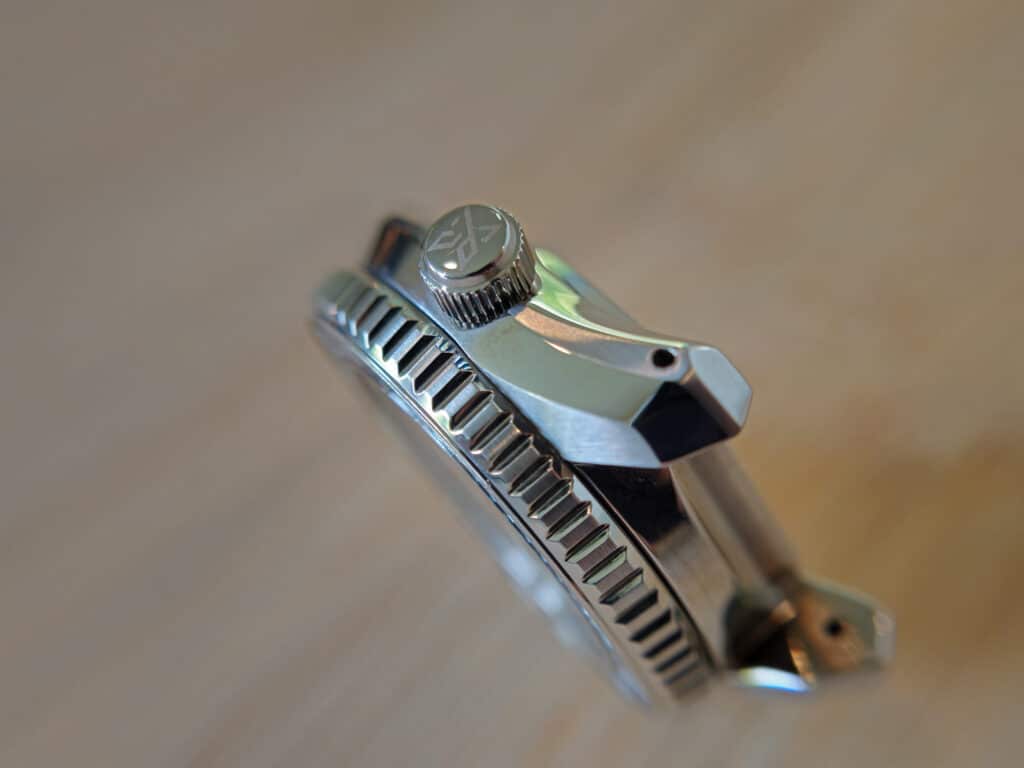
The polished flanks of this watch reflect light like a mirror, and dramatically decrease the wrist presence. This sculpted case with immaculately polished sides in combination with a rather small 28.5mm diameter dial is what allows this watch to wear smaller than the specs indicate.
Classic Seiko Diver Bezel Action
The last thing to cover is the bezel and bezel action. The unidirectional bezel sits proudly on the case, easily making up about a third of the case’s overall thickness. Because of this it is easily manipulated, even with gloved hands. It is brushed in the inner section of the gear tooth textured edges with a polished bevel on the top.
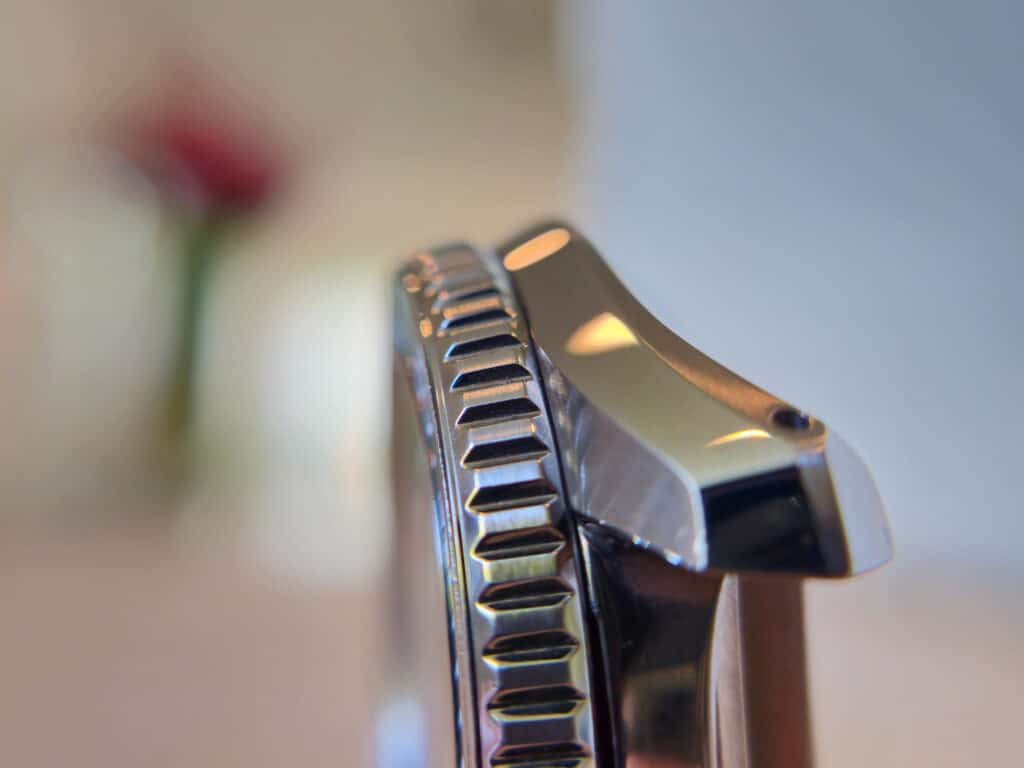
The action is easily identifiable as a Seiko, but a Seiko that was an apprentice to a bank vault. It’s not crisp, precise, and light like a Submariner or Seamaster, instead it feels consistently firm and smooth. Rather than a bezel that exists click to click, the Marinemaster’s bezel has the fluid feel of a combination lock accentuated with clicks. It’s hard to describe and it feels wonderful to use and luxurious, just not in a typical Swiss made way that I and maybe you are accustomed to.
Vibrant and Revamped Seiko Prospex Marinemaster Dial
Speaking of the dial, it is exceptionally done. Much has been made of the removal of the word ‘Marinemaster’ from the dial of the previous SBDX001 Seiko Marinemaster model. While I would prefer to have it printed on there for all to see, I do enjoy the symmetry of the Prospex logo and accompanying text.
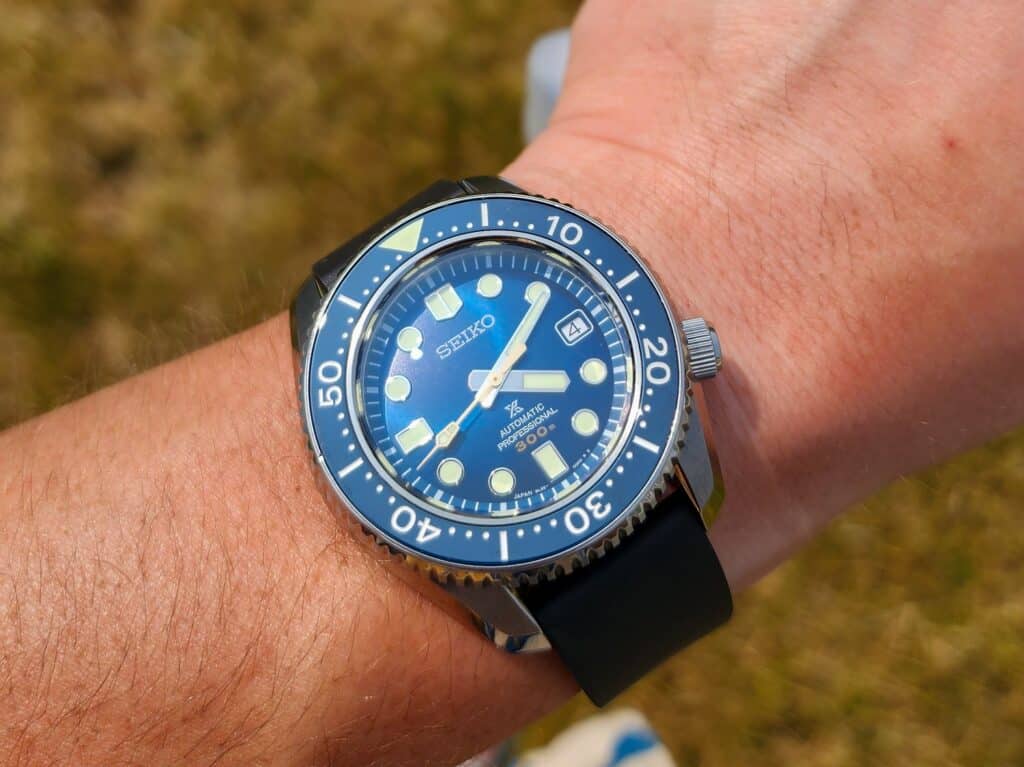
The blue dial is vibrant and its sunburst effect pops in the sunlight. I think this is one of the best blue dials in the attainable watch world. It holds its color in nearly all light which cannot be said for most blue watches, and the golden highlights of the second hand and the ‘300M’ text are perfect accents. There is also a black dial version under the SLA021J1 model reference.
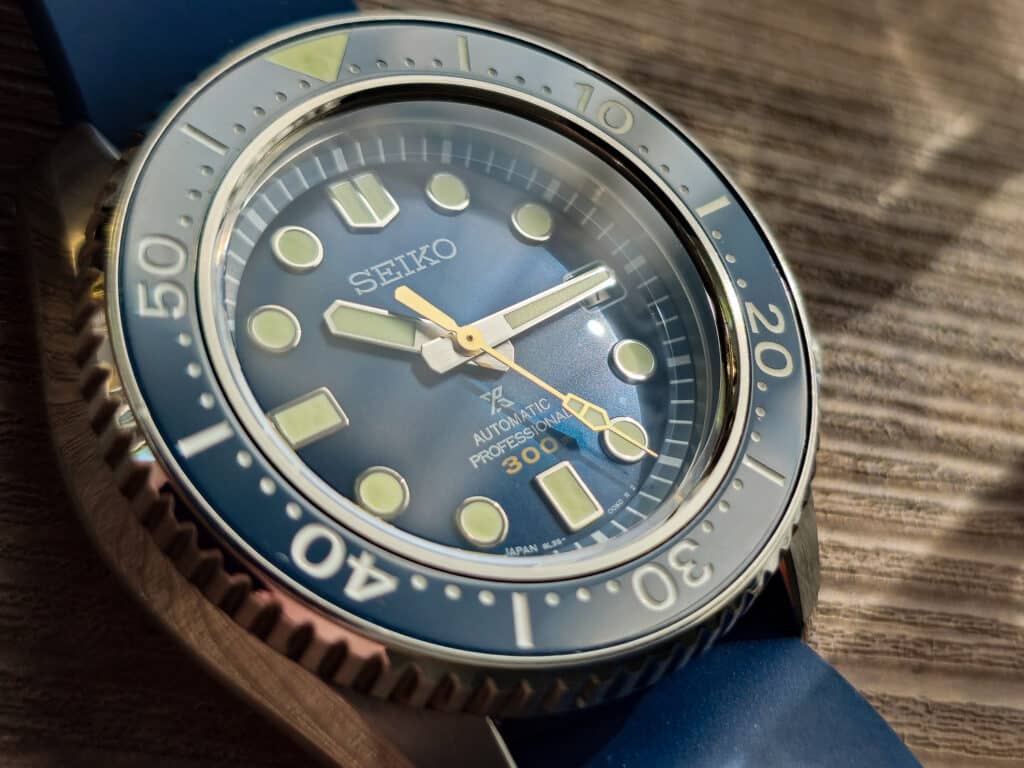
The indices do not have the same thick, fluffy look that earlier the Marinemasters’ hand-applied indices had, which is a genuine shame. However they are done with great precision nonetheless. The date wheel is crisply framed and has a metallic sheen that exudes attention to detail.
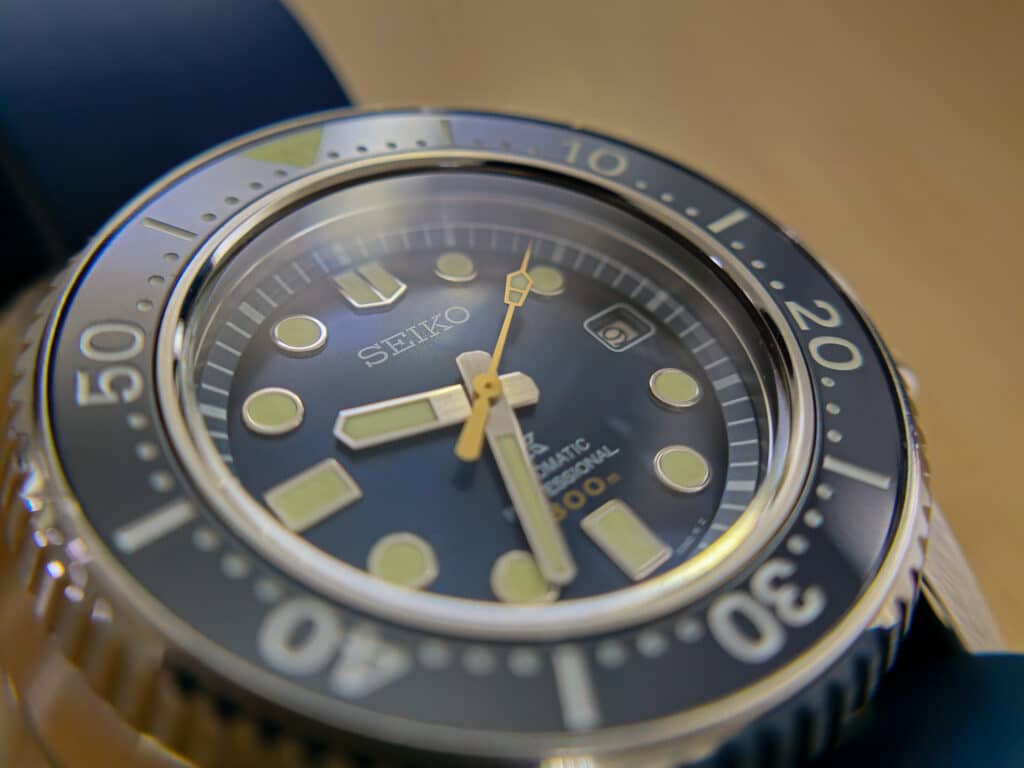
One of the truly best in class features of this watch is the lume. Seiko LumiBrite is always near the top of the lume pyramid, but the Marinemaster is truly the capstone of all lume. Its bright and lasts literally all night, and the ceramic bezel is nicely lumed up to the 20 minute marker. Unless you prefer the consistency of something like tritium, the Marinemaster is unbeatable!
Hand Assembled In-House Movement
Powering the Marinemaster is the high grade fully in-house 8L35. This is a Grand Seiko movement, and has an improved beat rate of 28,800bph over the standard 21,600bph common in most Seikos. This movement is hand assembled at the Shizuku-ishi watch Studio in Morioka, and it is truly rare to get a hand assembled movement at this price point. While Seiko refuses to give tighter accuracy specs than their standard -10 to +15 seconds per day, I have never encountered an 8L series movement that was more than +/-4 a seconds a day. The workhorse movement cliche is over used, but this fits the bill as the 8L35 is well proven and reliable. This movement is reason alone enough to upgrade from a mid tier Seiko Prospex model with a 6R series movement.
The Marinemaster has an interesting history in regard to what movements the model has used. Other featured movements have included spring drive (SBDB011, which was also a GMT), hi-beat movements (SBEX001 limited edition), and many many. While most of these iterations have been phased out and discontinued, the SLA023/ SLA021 MM with the 8L35 is still part of the regular production.
Overall Thoughts
That is the story of the Seiko Marinemaster 300m. It’s an intensely Japanese luxury tool watch that has no substitute. You cannot get the same feeling this watch gives you by wearing either a Tudor Black Bay, Rolex Sub, or Omega Seamaster nor a cheaper Seiko diver. I tried for years to scratch the itch I had for the Marinemaster to no avail.
However, that is not exclusively a good thing. This watch is big and hard to wear, and in my opinion nearly impossible to wear on the included bracelet. It is very expensive for a Seiko that is not preceded by ‘Grand’, especially when its similarly priced alternatives have undisputed luxury brand status. It’s not a perfect watch, but I firmly believe its deficiencies add to its charm and persona rather than detract from it.
This watch would not be as special as it is without the large, thick, and hefty case. I used to dream about a nonexistent hypothetical Seiko Marinemaster that was 40mm wide and 13mm thick, now I am just not so sure that this unlikely watch would be an actual Marinemaster if Seiko got around to making one. With its exquisitely sculpted and executed case, deep dial, signature 4’clock crown, terrible bracelet, and heft on par with a solid gold watch, the Marinemaster 300m is quintessential Seiko. This watch brandishes rare keeper status in my personal collection, and I have a feeling if you give the Marinemaster a chance it might just find its way into your heart as well!

Ben is a midwesterner who was infected with the watch contagion when he needed a watch to time his long runs in high-school. Now as a mildly functional family man his fleeting fascination has hemorrhaged into terminal obsession of all things clocks and watches. He loves hunting for eclectic watches well off the beaten path. Adequate culinary concoctions, mediocre photography, and massive enthusiasm for cars and all of the dying sci-fi franchises round out his other passions.
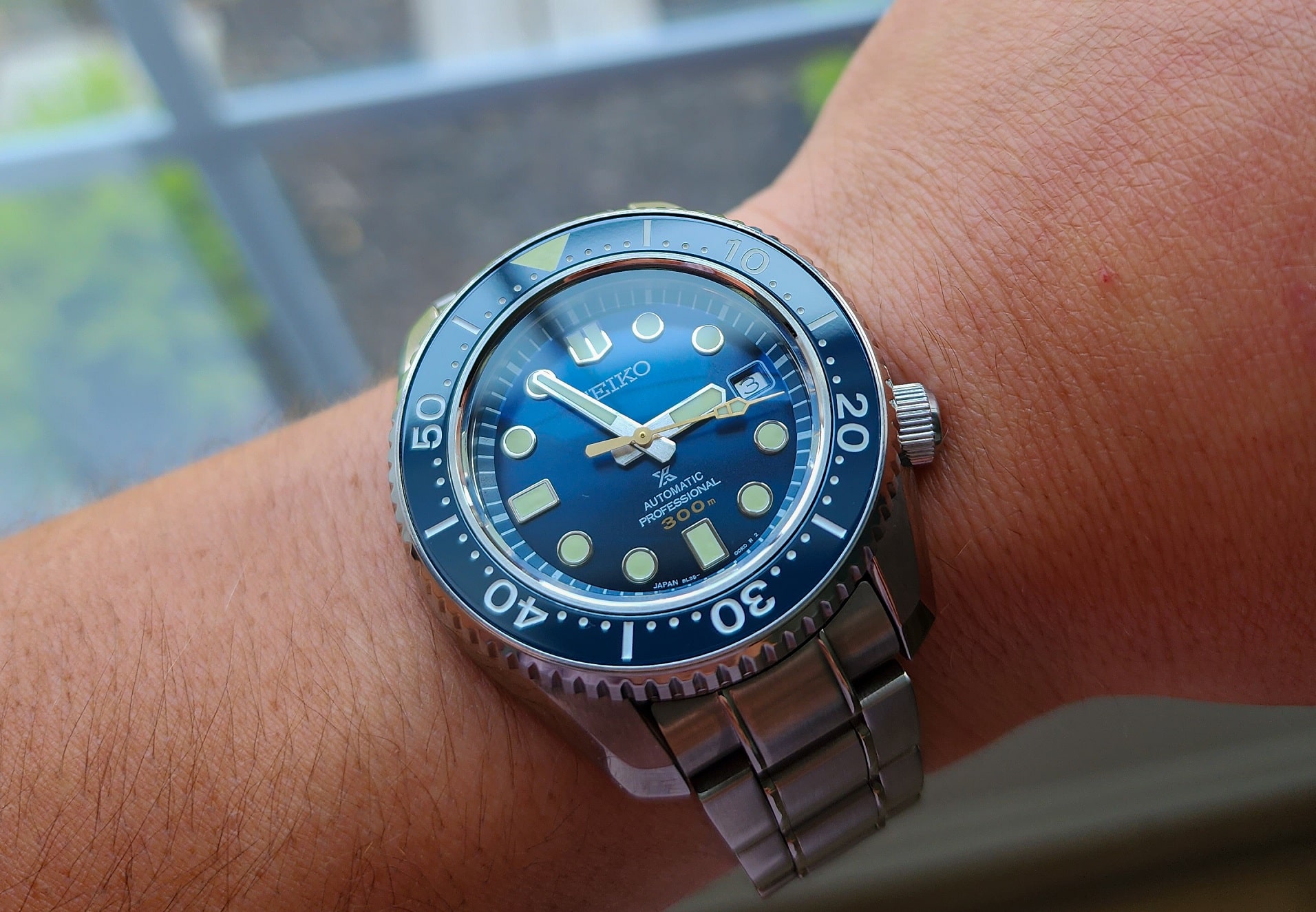
Hi Ben.
Great review. Thank you for your efforts in writing this up.
I purchased the SLA017 a couple of years ago and to add to my collection of watches which are, by choice, mainly Seiko. I’ve had many Tudor and Rolex watches up until about 5 years ago when I started understanding what Seiko as a watch brand, were all about.
From then on, my grail watch was the MM300.
I love the quirkiness of the monoblock case and the hand assembled movement. I also don’t mind the bracelet!! I know it is not on a par with others in this price point but because of its design and inherent shortcomings, I think it gives the watch even more character?!
Anyway, a keeper for sure. Every other watch I’ve got is not ever going to be a lifetime companion like my MM300 is!👍😃
I’ve had my marine master 300 since 2004 and quite enjoy the bracelet. I just never liked the short minute hand and had it replaced with a longer Omega style one and had the seconds hand painted orange at the tip. I found a watch maker about 11 years ago that could open those watches and replaced it with a sapphire crystal. I’ve had it lightly sand blasted about a decade ago which I much preferred over the polished finish. Anyways I’ve had it this long it’s not going anywhere.
Great review. I own the green 140th anniversary “Iriomote Island” SLA047 and absolutely love it. Unlike you though, I love the stock bracelet and wouldn’t think of swapping it out. While the links are as long as you say, it still forms beautifully to my 7.25” wrist and is perhape the most comfortable bracelet I’ve ever worn that wasn’t made by Rolex. Unlike most bracelets on watches that costless than the MM300 the edges of every link are smooth, allowing it to slide effortlessly over my wrist as I move and never pinching, never pulling hairs and never irritating my skin like most sharper edged bracelets do. Its not as smooth and comfortable as the bracelet on my Rolex Milgauss which is the best I’ve ever tried, but it is better than those of my Vertex M100 and M60, and better than that of the Tudor Black Bay Pro and Black Bay 58 I tried.
Everything else is exatly as you say it is. The Zaratsu polishing is next level and makes the polishing on my Milgauss look ordinary (it was previously my best), the hour and minute hands are just exquisite, though second hand looks cheap. The green dial responds to changing light in infinite and beautiful ways, ranging from near inky black to a lush forest green in bright sub, and usually looking somewhat like British Racing Green in most indoor settings.
This is a keeper.
Great review!
Could someone tell me how heavy the watch is without the bracelet?
What blue fkm Strap did you use? Which brand? Need too find one that would hold the case centered too my wrist